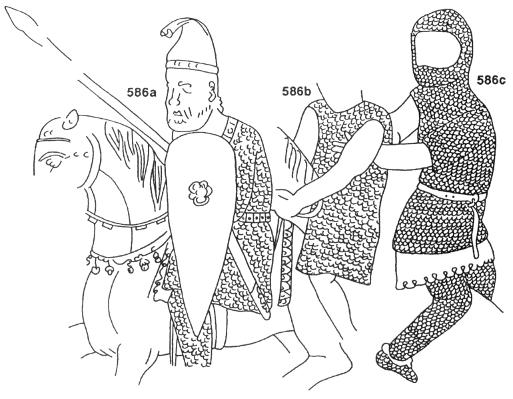
Create an Amazon Business Account

Lucca - Toskana : um 1185 Taufbecken in der Kirche San Frediano. Das Relief am Taufbecken zeigt die Geschichte Moses, hier der Durchzug durch das Rote Meer. Die Äqypter werden als Ritter in den Rüstungen des späten 12. Jh dargestellt. Der vordere Ritter trägt einen zweiteiligen Kettenpanzer bestehend aus langem Kettenhemd ohne Kapuze und Kettenhosen. Der Schild zeigt die für das 12. Jhd. typische Mandelform. Zwei Ritter auf einem Pferd ist ein Motiv, das gerne mit dem Templerorden in Verbindung gebracht wird.
Lucca - Tuscany: by 1185. Baptismal font in the Church of San Frediano. The relief on the baptismal font shows the story of Moses, here the crossing of the Red Sea. The Egyptians are represented as knights in the armour of the late 12th century. The front knight wearing a two-piece chainmail consisting of long mail without hood and mail chauses. The shield shows for the 12th century a typical almond shape. Two knights on a horse is a subject that is often associated with the Knights Templar.
Photos by Hen Magonza
At the entrance of the basilica is the huge 12th-century Romanesque baptismal font (the Fonte Lustrale). It is composed of a bowl, covered with a tempietto, resting on pillars, inside a circular basin. It is the craftmanship of master Roberto (his signature is on the basin) and two unknown masters. The basin is decorated with The Story of Moses by a Lombard sculptor. Master Roberto did the last two panels The Good Shepherd and the Six Prophets. The tempietto was sculpted by a Tuscan master, representing the months of the year and the apostles.

Referenced on p.222, Arms and Armour of the Crusading Era, 1050-1350, Western Europe and the Crusader States by David Nicolle
586A-C 'Pharaoh's army', carved font, Tuscany, late 12th century
(in situ Church of S. Frediano, Lucca, Italy)
With the exception of the ruler's perhaps fanciful hat or helmet (A) the military equipment carved on the S. Frediano font seems to be very realistic. Yet it still includes some unusual features, the most obvious being a sleeveless mail hauberk (B) and another which might have only one short sleeve (C). Such a system would seem suitable for archers, if it actually existed. Otherwise the carving illustrates a hauberk with a coif (C), another without (A), and mail chausses (A and C) The leading figure also has his scabbard hanging from a decorated sword-belt.